CBSU bibliography search
To request a reprint of a CBSU publication, please
click here to send us an email (reprints may not be available for all publications)
Assessing Cognition in the Vegetative State
Authors:
OWEN, A. M., Coleman, M.R., Menon, D., K., Pickard, J. D
Reference:
Helix Review Series: Neurology and Cognitive Neuroscience
Year of publication:
2008
CBU number:
6407
Abstract:
This article was reported but no comprehensive
record of the journal or the article can be found. It might have been changed to another title or be in another journal. The original author did not give any more details but it is left here (with an estimation of a 2008 publication date) in case of any references made that will be found by researchers in the future.
In recent years, a number of studies have demonstrated an important role for functional neuroimaging in the identification of residual cognitive function in the vegetative state (VS). Such studies, when successful, may be particularly useful where there is concern about the accuracy of the diagnosis and the possibility that residual cognitive function has remained undetected. Unfortunately, functional neuroimaging in the vegetative state is extremely complex and subject to numerous methodological, clinical and theoretical difficulties. Here, we describe the strategy used to study residual auditory and speech processing in a single patient with a clinical diagnosis of vegetative state. Identical positron emission tomography studies, conducted nine months apart, revealed preserved and consistent responses in predicted regions of auditory cortex in response to intelligible speech stimuli. Moreover, a preliminary fMRI examination at the time of the second session revealed partially intact responses to semantically ambiguous stimuli, which are known to tap higher aspects of speech comprehension.
On this basis, we argue that there is a clear need to improve our characterisation of the clinical syndrome of VS. Functional neuroimaging has a major role to play in this context, not only in providing important new information that may assist diagnosis, but also to stratify patients in terms of the depth and breadth of residual cognitive functioning.

 MRC Cognition and Brain Sciences Unit
MRC Cognition and Brain Sciences Unit

